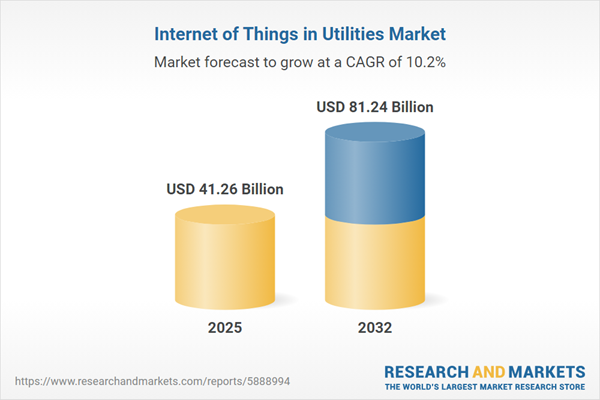Speak directly to the analyst to clarify any post sales queries you may have.
The Internet of Things in Utilities Market is driving strategic change for utility leaders by enabling faster digital transformation and heightened operational resilience. Senior decision-makers are now leveraging connected technologies to optimize critical infrastructure, streamline process automation, and support evolving regulatory and sustainability priorities.
Market Snapshot: Internet of Things in Utilities Market
Utility providers worldwide are accelerating their investment in IoT platforms to build operational agility, modernize aging networks, and continuously adapt to new customer and compliance expectations. The Internet of Things in Utilities Market is projected to increase from USD 37.41 billion in 2024 to USD 41.26 billion by 2025, reflecting a 10.18% CAGR. As connectivity becomes universal across the sector, utilities increasingly rely on real-time analytics and predictive maintenance for both day-to-day management and rapid response to unexpected events. The adoption of automated workflows and AI-driven intelligence is further optimizing infrastructure, supporting new business entrants, and fostering cross-regional innovation.
Scope & Segmentation
This report offers a comprehensive analysis of B2B IoT adoption across utility operations. Segmentation highlights the areas where emerging technologies and investment strategies are delivering measurable improvements for stakeholders.
- Component: PLC controllers, remote terminal units, metering devices, intelligent sensors, network gateways, core software, monitoring systems, and professional integration or consulting services all maximize data management and network performance.
- Solution: Asset tracking, process automation, cybersecurity, advanced metering, demand-side optimization, and infrastructure enhancements boost utilities’ ability to meet regulatory standards and sustain reliability.
- End Use: Applications are evident in commercial energy, industrial utilities, residential systems, public water and gas, municipal operations, agricultural resource management, and bespoke industry solutions.
- Application: Fault detection, real-time and offline condition monitoring, automated load balancing, and demand-response scheduling enable proactive risk mitigation and operational stability.
- Communication Technology: Utilities deploy 4G/5G, LPWAN (LoRaWAN, NB-IoT), RF mesh (Wi-SUN, Zigbee), satellite, and traditional wired networks to ensure scalable, secure, and reliable connectivity across varied environments.
- Deployment Mode: Cloud-based, on-premise, public, private, and hybrid deployment models offer flexibility for addressing utility-specific security, privacy, and compliance requirements.
- Geographic Regions: Analysis covers the Americas, Europe, Middle East & Africa, and Asia-Pacific, with insights into local investment, regulatory frameworks, and technology ecosystem development that shape IoT deployment momentum.
- Leading Companies Covered: Cisco Systems, IBM, Siemens, Schneider Electric, General Electric, Microsoft, ABB, Itron, Landis+Gyr, and Oracle demonstrate best practices in solution integration, network reliability, and adoption of open standards throughout utility operations.
Key Takeaways for Utility Stakeholders
- Integrated IoT platforms provide a foundation for efficient system upgrades, aligning operational practices with ever-evolving sustainability and compliance mandates.
- The move to edge computing and cloud infrastructures is enhancing asset visibility and enabling utilities to proactively manage networks, helping reduce reliance on manual and legacy approaches.
- Collaboration with technology partners and systems integrators is facilitating the swift modernization of utility frameworks, expediting project timelines and operational transformation.
- Strengthening cybersecurity investment is supporting improved data governance, offering greater assurance of continuous operation and building confidence in connected utility systems.
- Regional market dynamics are increasingly significant; for instance, Asia-Pacific utilities focus on integrating distributed energy resources, while EMEA counterparts emphasize data privacy and compliance readiness.
- Utility procurement models are evolving to be more responsive, enabling faster adaptation to economic fluctuations and digital transformation pressures.
Tariff Impact on Utility IoT Deployments
Recent tariff shifts in the United States are prompting utilities to reassess their procurement and sourcing strategies. Many organizations are adopting dual or multisource relationships and prioritizing regional supplier partnerships to minimize risk from volatile trade environments and reduce supply chain disruptions. This adjustment is encouraging the adoption of open standards and greater interoperability, which supports broad compliance objectives and reinforces supply network resilience across the sector.
Methodology & Data Sources
The report draws on executive interviews, in-depth regulatory reviews, analysis of authoritative white papers, and triangulation with reputable third-party market data. This transparent approach yields actionable recommendations for utility sector leadership.
Why This Report Matters
- Provides clear operational benchmarks and proven best practices to support digital transformation and strategic positioning within the modern utility landscape.
- Enables executive teams to navigate rapidly shifting regulation and operational complexity with focused, data-driven guidance.
- Supplies targeted analysis on cybersecurity, procurement, and regional implementation, informing resilient planning and robust risk management.
Conclusion
This report equips utility executives with actionable intelligence to drive modernization and strengthen stakeholder confidence. Informed strategies enable organizations to address sector challenges and sustain competitive advantage in an evolving market.
Additional Product Information:
- Purchase of this report includes 1 year online access with quarterly updates.
- This report can be updated on request. Please contact our Customer Experience team using the Ask a Question widget on our website.
Table of Contents
3. Executive Summary
4. Market Overview
7. Cumulative Impact of Artificial Intelligence 2025
Companies Mentioned
The companies profiled in this Internet of Things in Utilities market report include:- Cisco Systems, Inc.
- IBM Corporation
- Siemens Aktiengesellschaft
- Schneider Electric SE
- General Electric Company
- Microsoft Corporation
- ABB Ltd
- Itron, Inc.
- Landis+Gyr AG
- Oracle Corporation
Table Information
| Report Attribute | Details |
|---|---|
| No. of Pages | 190 |
| Published | November 2025 |
| Forecast Period | 2025 - 2032 |
| Estimated Market Value ( USD | $ 41.26 Billion |
| Forecasted Market Value ( USD | $ 81.24 Billion |
| Compound Annual Growth Rate | 10.1% |
| Regions Covered | Global |
| No. of Companies Mentioned | 11 |









